 Technology peripherals
Technology peripherals
 AI
AI
 Make large models 'slim down' by 90%! Tsinghua University & Harbin Institute of Technology proposed an extreme compression solution: 1-bit quantization, while retaining 83% of the capacity
Make large models 'slim down' by 90%! Tsinghua University & Harbin Institute of Technology proposed an extreme compression solution: 1-bit quantization, while retaining 83% of the capacity
Make large models 'slim down' by 90%! Tsinghua University & Harbin Institute of Technology proposed an extreme compression solution: 1-bit quantization, while retaining 83% of the capacity
Quantification, pruning and other compression operations on large models are the most common part of deployment.
However, how big is this limit?
A joint study by Tsinghua University and Harbin Institute of Technology gave the answer:
90%.
They proposed a large model 1-bit extreme compression framework OneBit, which for the first time achieved weight compression of large models exceeding 90% and retained most (83%) capabilities .
It can be said that playing is about "wanting and wanting"~

Let's take a look.
The 1-bit quantization method for large models is here
From pruning and quantization to knowledge distillation and low-rank weight decomposition, large models can already compress a quarter of the weight with almost no loss.
Weight quantization typically converts the parameters of a large model into a low bit-width representation. This can be achieved by transforming a fully trained model (PTQ) or introducing a quantization step during training (QAT). This approach helps reduce the computational and storage requirements of the model, thereby improving model efficiency and performance. By quantizing weights, the size of the model can be significantly reduced, making it more suitable for deployment in resource-constrained environments, while also
However, existing quantization methods face severe performance losses below 3bit, This is mainly due to:
- The existing parameter low bit width representation method has serious accuracy loss at 1 bit. When the parameters based on the Round-To-Nearest method are expressed in 1 bit, the converted scaling coefficient s and zero point z will lose their practical meaning.
- The existing 1-bit model structure does not fully consider the importance of floating point precision. The lack of floating point parameters may affect the stability of the model calculation process and seriously reduce its own learning ability.
In order to overcome the obstacles of 1-bit ultra-low bit width quantization, the author proposes a new 1-bit model framework: OneBit, which includes a new 1-bit linear layer structure, SVID-based parameter initialization method and quantization-based perception Deep transfer learning for knowledge distillation.
This new 1-bit model quantization method can retain most of the capabilities of the original model with a huge compression range, ultra-low space occupation and limited computing cost. This is of great significance for the deployment of large models on PCs and even smartphones.
Overall Framework
The OneBit framework generally includes: a newly designed 1-bit model structure, a method of initializing quantified model parameters based on the original model, and deep capability migration based on knowledge distillation.
This newly designed 1-bit model structure can effectively overcome the serious accuracy loss problem in 1-bit quantization in previous quantization work, and shows excellent stability during training and migration.
The initialization method of the quantitative model can set a better starting point for knowledge distillation, accelerate convergence and achieve better capability transfer effects.
1. 1bit model structure
1bit requires that each weight value can only be represented by 1 bit, so there are only two possible states at most.
The author chooses ±1 as these two states. The advantage is that it represents two symbols in the digital system and has more complete functions. At the same time, it can be easily obtained through the Sign(·) function.
The author's 1bit model structure is achieved by replacing all linear layers of the FP16 model (except the embedding layer and lm_head) with 1bit linear layers.
In addition to the 1-bit weight obtained through the Sign(·) function, the 1-bit linear layer here also includes two other key components—the value vector of FP16 precision.
△Comparison of FP16 linear layer and OneBit linear layer
This design not only maintains the high rank of the original weight matrix, but also provides The necessary floating point precision is meaningful to ensure a stable and high-quality learning process.
As can be seen from the above figure, only the value vectors g and h maintain the FP16 format, while the weight matrix is all composed of ±1.
The author can take a look at OneBit's compression capabilities through an example.
Assuming that a 40964096 FP16 linear layer is compressed, OneBit requires a 40964096 1-bit matrix and two 4096*1 FP16 value vectors.
The total number of bits is 16,908,288, and the total number of parameters is 16,785,408. On average, each parameter occupies only about 1.0073 bits.
This kind of compression range is unprecedented and can be said to be a true 1bit LLM.
2. Parameter initialization and transfer learning
In order to use the fully trained original model to better initialize the quantized model, the author proposes a new parameter matrix The decomposition method is called "value-sign independent matrix factorization (SVID)".
This matrix decomposition method separates symbols and absolute values, and performs rank-1 approximation on absolute values. Its method of approximating the original matrix parameters can be expressed as:

Rank-1 approximation can be achieved by common matrix factorization methods, such as singular value decomposition (SVD) and nonnegative matrix factorization (NMF).
The author mathematically shows that this SVID method can match the 1-bit model framework by exchanging the order of operations, thereby achieving parameter initialization.
In addition, the contribution of the symbolic matrix to approximating the original matrix during the decomposition process has also been proven. See the paper for details.
The author believes that an effective way to solve ultra-low bitwidth quantization of large models may be quantization-aware training QAT.
Therefore, after SVID gives the parameter starting point of the quantitative model, the author uses the original model as the teacher model and learns from it through knowledge distillation.
Specifically, the student model mainly receives guidance from the logits and hidden state of the teacher model.
During training, the values of the value vector and parameter matrix will be updated, and during deployment, the quantized 1-bit parameter matrix can be used directly for calculation.
The larger the model, the better the effect
The baselines selected by the author are FP16 Transformer, GPTQ, LLM-QAT and OmniQuant.
The last three are all classic strong baselines in the field of quantification, especially OmniQuant, which is the strongest 2-bit quantization method before the author.
Since there is currently no research on 1-bit weight quantization, the author only uses 1-bit weight quantization for the OneBit framework, and adopts 2-bit quantization settings for other methods.
For distilled data, the author followed LLM-QAT and used teacher model self-sampling to generate data.
The author uses models of different sizes from 1.3B to 13B, OPT and LLaMA-1/2 in different series to prove the effectiveness of OneBit. In terms of evaluation indicators, the perplexity of the verification set and the zero-shot accuracy of common sense reasoning are used. See the paper for details.
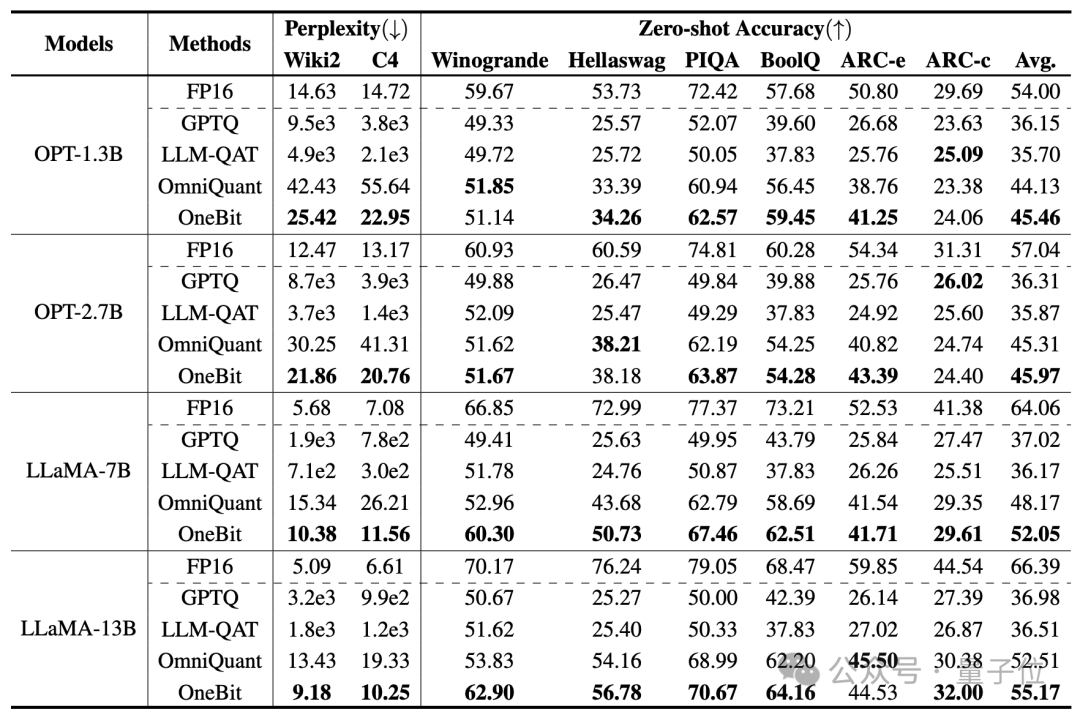
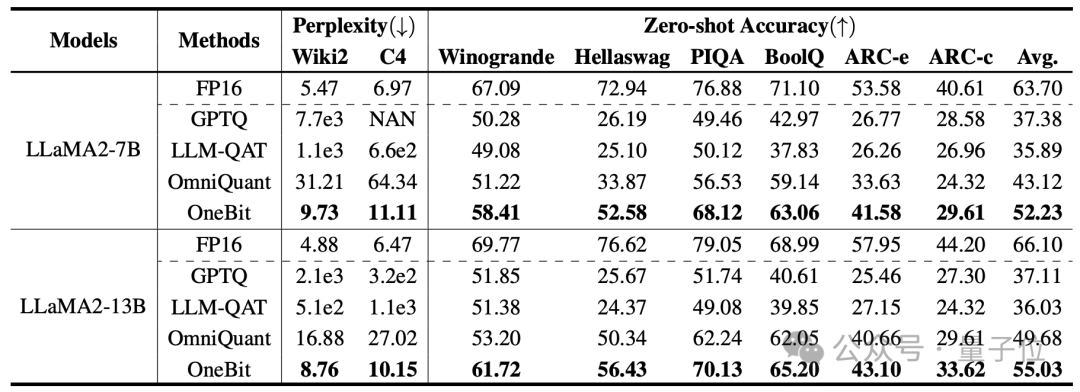
The above table shows the advantages of OneBit compared to other methods in 1-bit quantization. It is worth noting that the larger the model, the better the OneBit effect is.
As the model size increases, the OneBit quantitative model reduces the perplexity more than the FP16 model.
The following are the common sense reasoning, world knowledge and space occupation of several different small models:
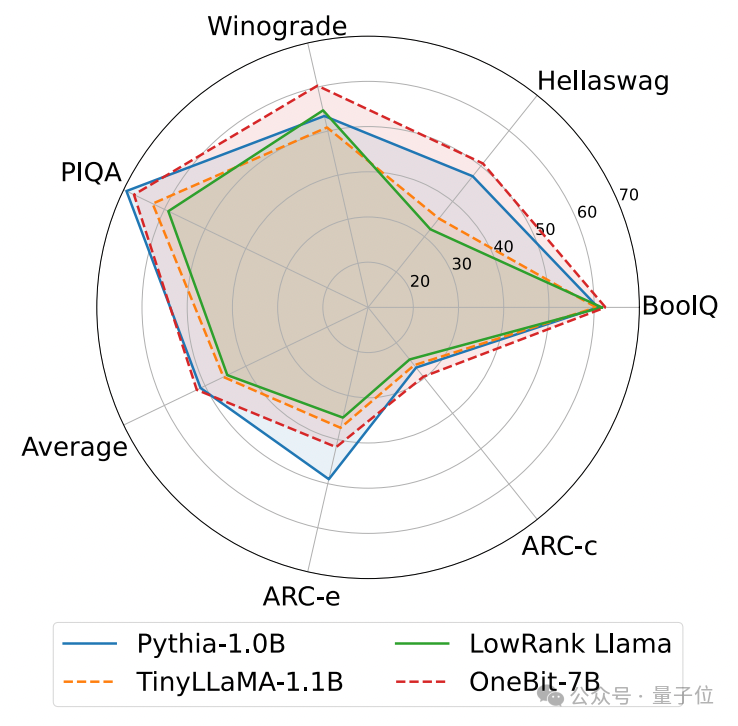

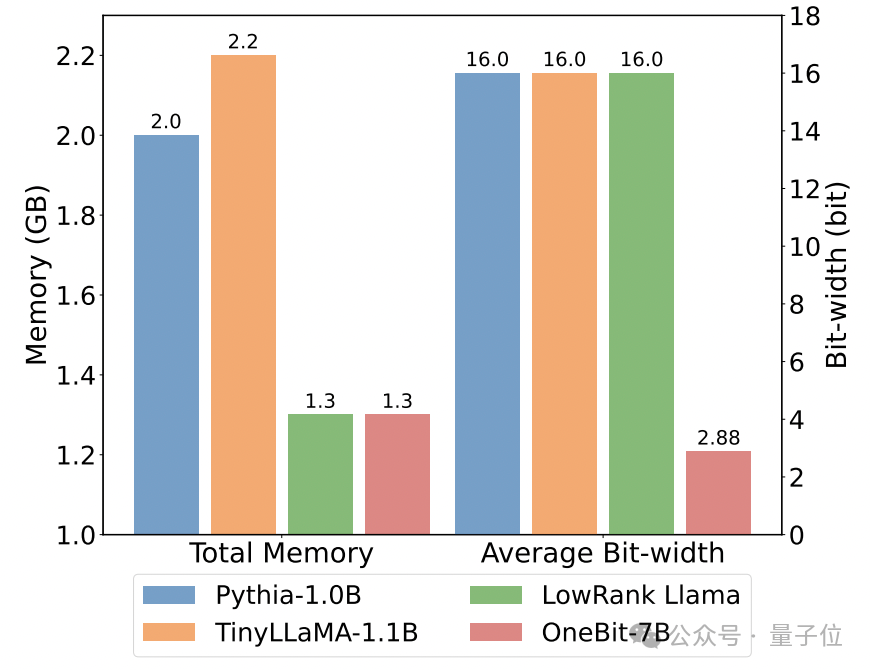
The author also compared the size and actual capabilities of several different types of small models.
The author found that although OneBit-7B has the smallest average bit width, takes up the smallest space, and requires relatively few training steps, it is not inferior to other models in terms of common sense reasoning capabilities.
At the same time, the author also found that the OneBit-7B model has serious knowledge forgetting in the field of social sciences.
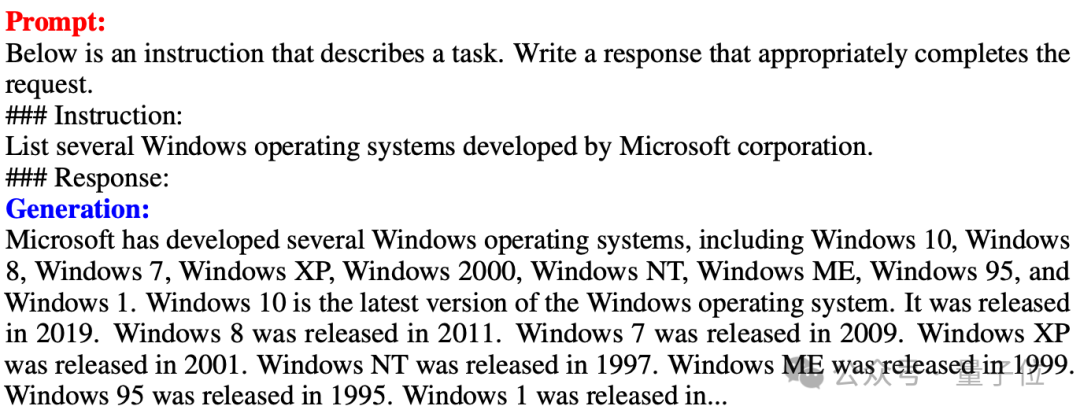
△Comparison of FP16 linear layer and OneBit linear layer An example of text generation after fine-tuning of OneBit-7B instructions
The above picture also shows a OneBit- Text generation example after fine-tuning the 7B instruction. It can be seen that OneBit-7B has effectively gained the ability of the SFT stage and can generate text relatively smoothly, although the total parameters are only 1.3GB (comparable to the 0.6B model of FP16). Overall, OneBit-7B demonstrates its practical application value.
Analysis and Discussion
The author shows the compression ratio of OneBit for LLaMA models of different sizes. It can be seen that the compression ratio of OneBit for the model exceeds an astonishing 90%.
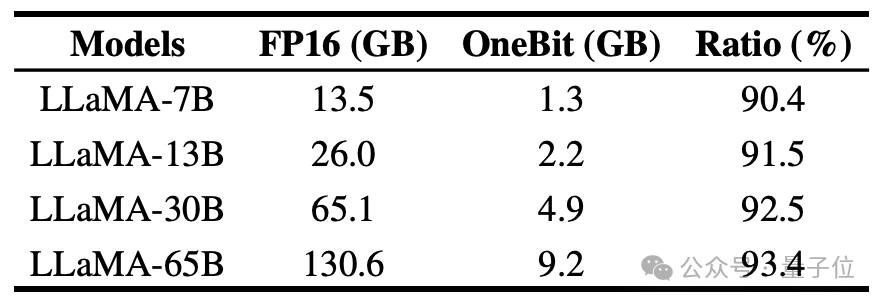
#In particular, as the model increases, the compression ratio of OneBit becomes higher.
This shows the advantage of the author's method on larger models: greater marginal gain (perplexity) at a higher compression ratio. Furthermore, the authors' approach achieves a good trade-off between size and performance. 
1bit quantitative model has computational advantages and is of great significance. The pure binary representation of parameters can not only save a lot of space, but also reduce the hardware requirements of matrix multiplication.
The element multiplication of matrix multiplication in high-precision models can be turned into efficient bit operations. Matrix products can be completed with only bit assignments and additions, which has great application prospects.
In addition, the author's method maintains excellent stable learning capabilities during the training process.
In fact, the instability problems, sensitivity to hyperparameters and convergence difficulties of binary network training have always been concerned by researchers.
The author analyzes the importance of high-precision value vectors in promoting stable convergence of the model.
Previous work has proposed a 1-bit model architecture and used it to train models from scratch (such as BitNet [1]), but it is sensitive to hyperparameters and difficult to transfer learning from a fully trained high-precision model. The author also tried BitNet's performance in knowledge distillation and found that its training was not stable enough.

Summary
The author proposed a model structure for 1-bit weight quantization and the corresponding parameter initialization method.
Extensive experiments on models of various sizes and series show that OneBit has clear advantages on representative strong baselines and achieves a good trade-off between model size and performance.
In addition, the author further analyzes the capabilities and prospects of this extremely low-bit quantization model and provides guidance for future research.
Paper address: https://arxiv.org/pdf/2402.11295.pdf
The above is the detailed content of Make large models 'slim down' by 90%! Tsinghua University & Harbin Institute of Technology proposed an extreme compression solution: 1-bit quantization, while retaining 83% of the capacity. For more information, please follow other related articles on the PHP Chinese website!

Hot AI Tools

Undresser.AI Undress
AI-powered app for creating realistic nude photos

AI Clothes Remover
Online AI tool for removing clothes from photos.

Undress AI Tool
Undress images for free

Clothoff.io
AI clothes remover

Video Face Swap
Swap faces in any video effortlessly with our completely free AI face swap tool!

Hot Article

Hot Tools

Notepad++7.3.1
Easy-to-use and free code editor

SublimeText3 Chinese version
Chinese version, very easy to use

Zend Studio 13.0.1
Powerful PHP integrated development environment

Dreamweaver CS6
Visual web development tools

SublimeText3 Mac version
God-level code editing software (SublimeText3)

Hot Topics
 1392
1392
 52
52
 Web3 trading platform ranking_Web3 global exchanges top ten summary
Apr 21, 2025 am 10:45 AM
Web3 trading platform ranking_Web3 global exchanges top ten summary
Apr 21, 2025 am 10:45 AM
Binance is the overlord of the global digital asset trading ecosystem, and its characteristics include: 1. The average daily trading volume exceeds $150 billion, supports 500 trading pairs, covering 98% of mainstream currencies; 2. The innovation matrix covers the derivatives market, Web3 layout and education system; 3. The technical advantages are millisecond matching engines, with peak processing volumes of 1.4 million transactions per second; 4. Compliance progress holds 15-country licenses and establishes compliant entities in Europe and the United States.
 Top 10 cryptocurrency exchange platforms The world's largest digital currency exchange list
Apr 21, 2025 pm 07:15 PM
Top 10 cryptocurrency exchange platforms The world's largest digital currency exchange list
Apr 21, 2025 pm 07:15 PM
Exchanges play a vital role in today's cryptocurrency market. They are not only platforms for investors to trade, but also important sources of market liquidity and price discovery. The world's largest virtual currency exchanges rank among the top ten, and these exchanges are not only far ahead in trading volume, but also have their own advantages in user experience, security and innovative services. Exchanges that top the list usually have a large user base and extensive market influence, and their trading volume and asset types are often difficult to reach by other exchanges.
 'Black Monday Sell' is a tough day for the cryptocurrency industry
Apr 21, 2025 pm 02:48 PM
'Black Monday Sell' is a tough day for the cryptocurrency industry
Apr 21, 2025 pm 02:48 PM
The plunge in the cryptocurrency market has caused panic among investors, and Dogecoin (Doge) has become one of the hardest hit areas. Its price fell sharply, and the total value lock-in of decentralized finance (DeFi) (TVL) also saw a significant decline. The selling wave of "Black Monday" swept the cryptocurrency market, and Dogecoin was the first to be hit. Its DeFiTVL fell to 2023 levels, and the currency price fell 23.78% in the past month. Dogecoin's DeFiTVL fell to a low of $2.72 million, mainly due to a 26.37% decline in the SOSO value index. Other major DeFi platforms, such as the boring Dao and Thorchain, TVL also dropped by 24.04% and 20, respectively.
 What does cross-chain transaction mean? What are the cross-chain transactions?
Apr 21, 2025 pm 11:39 PM
What does cross-chain transaction mean? What are the cross-chain transactions?
Apr 21, 2025 pm 11:39 PM
Exchanges that support cross-chain transactions: 1. Binance, 2. Uniswap, 3. SushiSwap, 4. Curve Finance, 5. Thorchain, 6. 1inch Exchange, 7. DLN Trade, these platforms support multi-chain asset transactions through various technologies.
 How to avoid losses after ETH upgrade
Apr 21, 2025 am 10:03 AM
How to avoid losses after ETH upgrade
Apr 21, 2025 am 10:03 AM
After ETH upgrade, novices should adopt the following strategies to avoid losses: 1. Do their homework and understand the basic knowledge and upgrade content of ETH; 2. Control positions, test the waters in small amounts and diversify investment; 3. Make a trading plan, clarify goals and set stop loss points; 4. Profil rationally and avoid emotional decision-making; 5. Choose a formal and reliable trading platform; 6. Consider long-term holding to avoid the impact of short-term fluctuations.
 Rexas Finance (RXS) can surpass Solana (Sol), Cardano (ADA), XRP and Dogecoin (Doge) in 2025
Apr 21, 2025 pm 02:30 PM
Rexas Finance (RXS) can surpass Solana (Sol), Cardano (ADA), XRP and Dogecoin (Doge) in 2025
Apr 21, 2025 pm 02:30 PM
In the volatile cryptocurrency market, investors are looking for alternatives that go beyond popular currencies. Although well-known cryptocurrencies such as Solana (SOL), Cardano (ADA), XRP and Dogecoin (DOGE) also face challenges such as market sentiment, regulatory uncertainty and scalability. However, a new emerging project, RexasFinance (RXS), is emerging. It does not rely on celebrity effects or hype, but focuses on combining real-world assets (RWA) with blockchain technology to provide investors with an innovative way to invest. This strategy makes it hoped to be one of the most successful projects of 2025. RexasFi
 WorldCoin (WLD) price forecast 2025-2031: Will WLD reach USD 4 by 2031?
Apr 21, 2025 pm 02:42 PM
WorldCoin (WLD) price forecast 2025-2031: Will WLD reach USD 4 by 2031?
Apr 21, 2025 pm 02:42 PM
WorldCoin (WLD) stands out in the cryptocurrency market with its unique biometric verification and privacy protection mechanisms, attracting the attention of many investors. WLD has performed outstandingly among altcoins with its innovative technologies, especially in combination with OpenAI artificial intelligence technology. But how will the digital assets behave in the next few years? Let's predict the future price of WLD together. The 2025 WLD price forecast is expected to achieve significant growth in WLD in 2025. Market analysis shows that the average WLD price may reach $1.31, with a maximum of $1.36. However, in a bear market, the price may fall to around $0.55. This growth expectation is mainly due to WorldCoin2.
 Ranking of leveraged exchanges in the currency circle The latest recommendations of the top ten leveraged exchanges in the currency circle
Apr 21, 2025 pm 11:24 PM
Ranking of leveraged exchanges in the currency circle The latest recommendations of the top ten leveraged exchanges in the currency circle
Apr 21, 2025 pm 11:24 PM
The platforms that have outstanding performance in leveraged trading, security and user experience in 2025 are: 1. OKX, suitable for high-frequency traders, providing up to 100 times leverage; 2. Binance, suitable for multi-currency traders around the world, providing 125 times high leverage; 3. Gate.io, suitable for professional derivatives players, providing 100 times leverage; 4. Bitget, suitable for novices and social traders, providing up to 100 times leverage; 5. Kraken, suitable for steady investors, providing 5 times leverage; 6. Bybit, suitable for altcoin explorers, providing 20 times leverage; 7. KuCoin, suitable for low-cost traders, providing 10 times leverage; 8. Bitfinex, suitable for senior play




